Category Archives: EDTC 300
My contribution to Classmates’ Learning
Over this term, I’ve taken every opportunity to support, motivate, and engage with my classmates through blog comments, shared resources, and participation in our Discord community. Being part of a connected, supportive group has helped me grow as a learner and future educator — and I’m proud of the ways I’ve contributed to the learning of others.
Commenting on Classmates’ Blogs
One of the ways I consistently supported my classmates was through meaningful blog comments. I made a point to reflect on their posts, offer encouragement, and inspire them to dive deeper into their ideas. When someone had a question or seemed unsure, I responded thoughtfully and often provided helpful resources to guide them.
I created a presentation that highlights several examples of my blog comments:
In many of these comments, I asked thoughtful questions, suggested tools, and shared personal connections to their topics. I also replied to classmates who responded to my comments, keeping the conversation going and showing continued interest in their learning.
Staying Active in the Discord Community
Throughout the course, I made it a priority to stay active in the Discord community. I frequently responded to questions, shared my own experiences, and offered encouragement when others needed help. I became part of several classmate discussions and group conversations, helping classmates with both technical and content-related questions.
Here are a few screenshots that show my contributions in our Discord space: 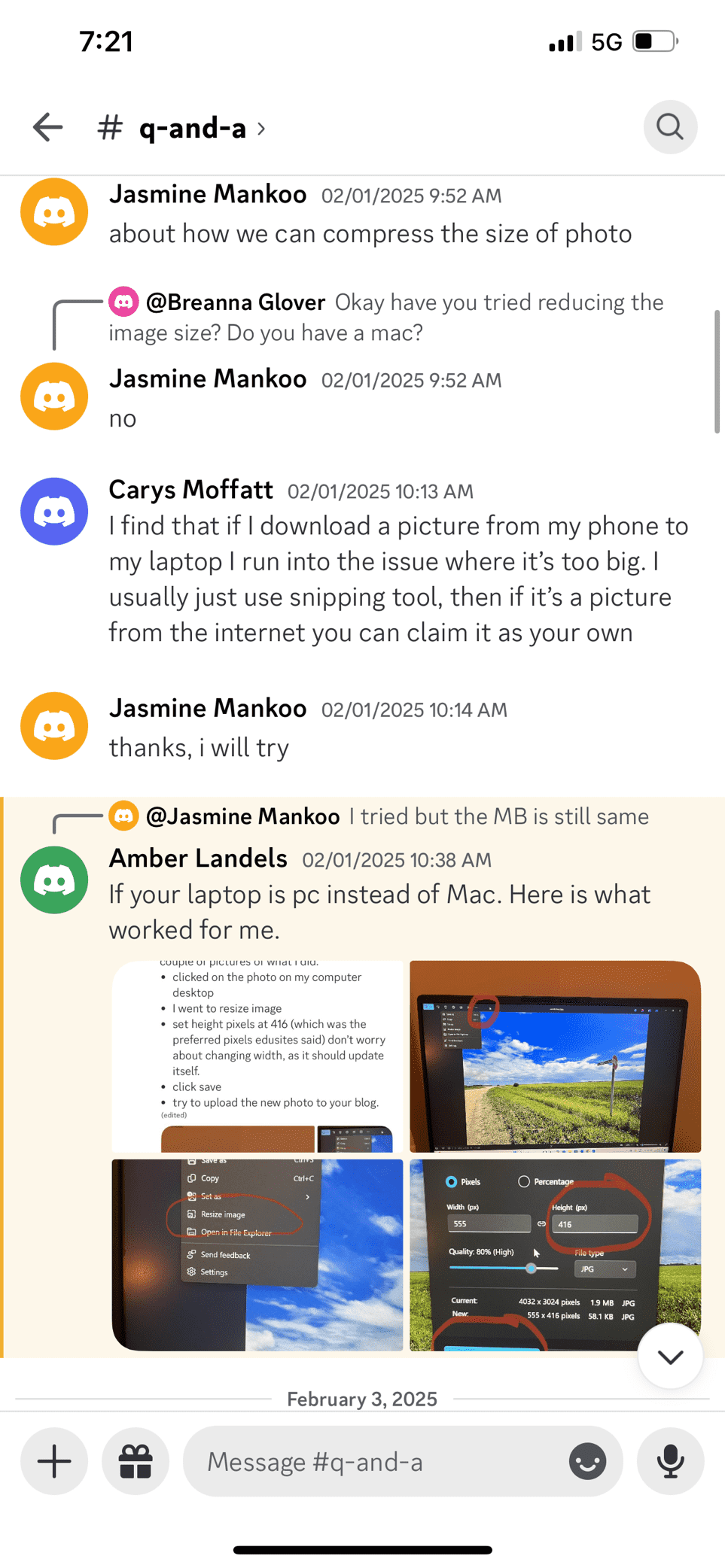

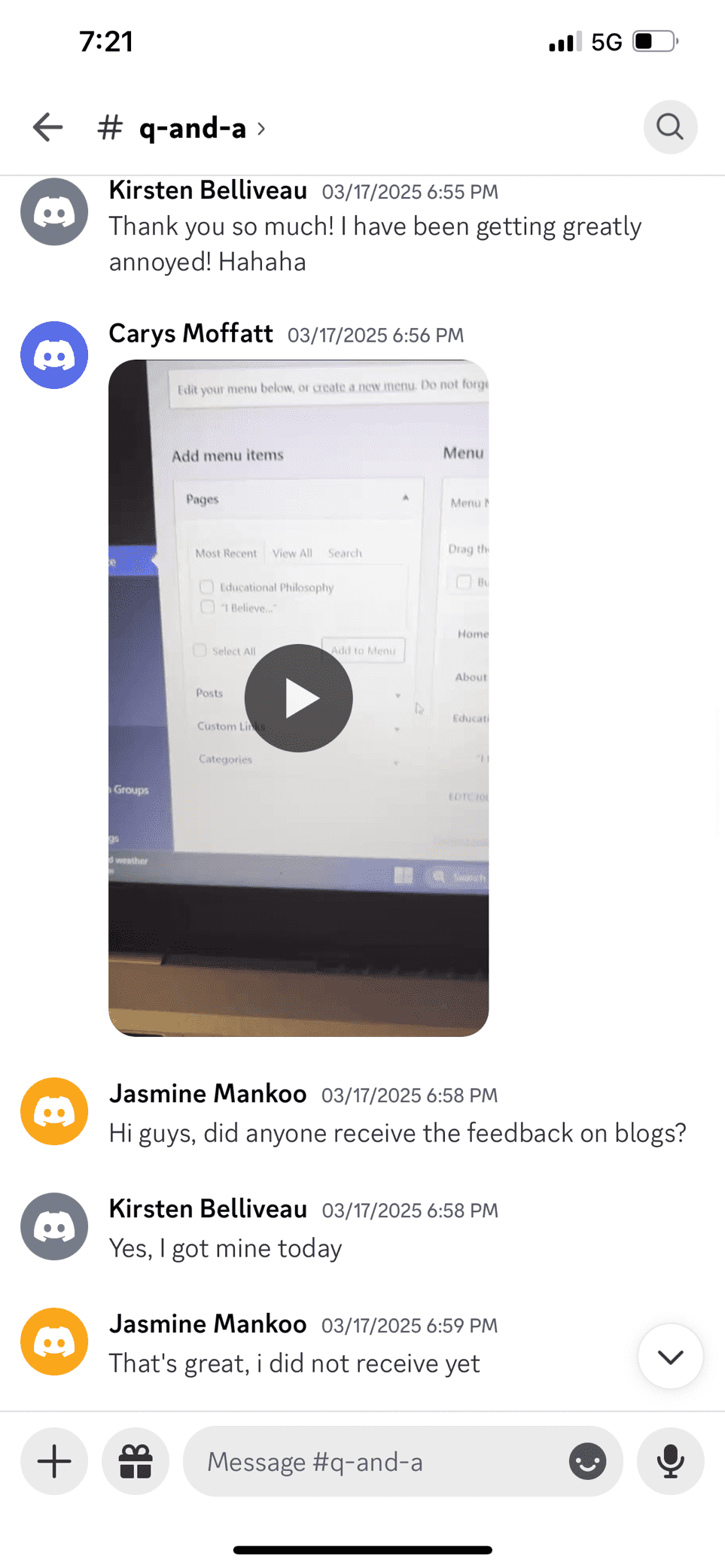
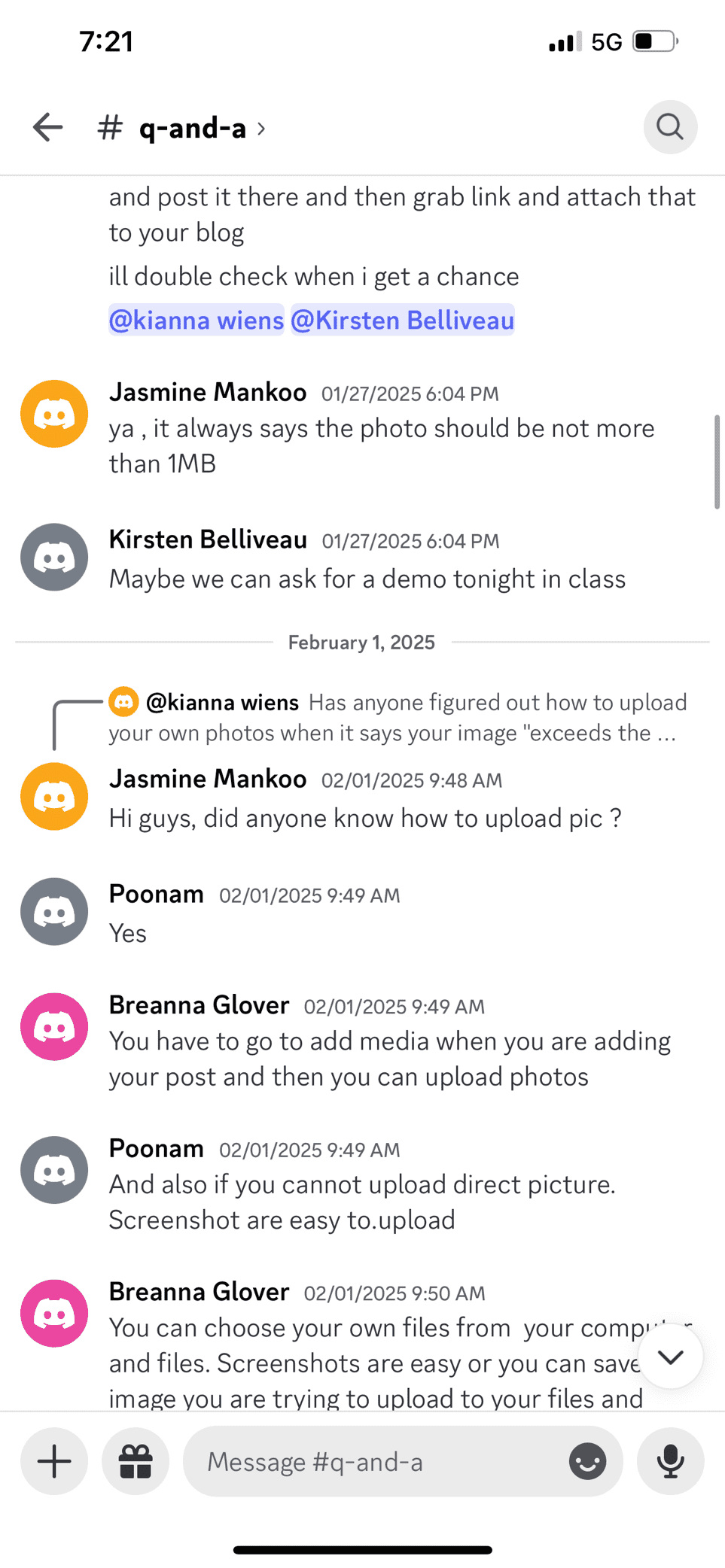
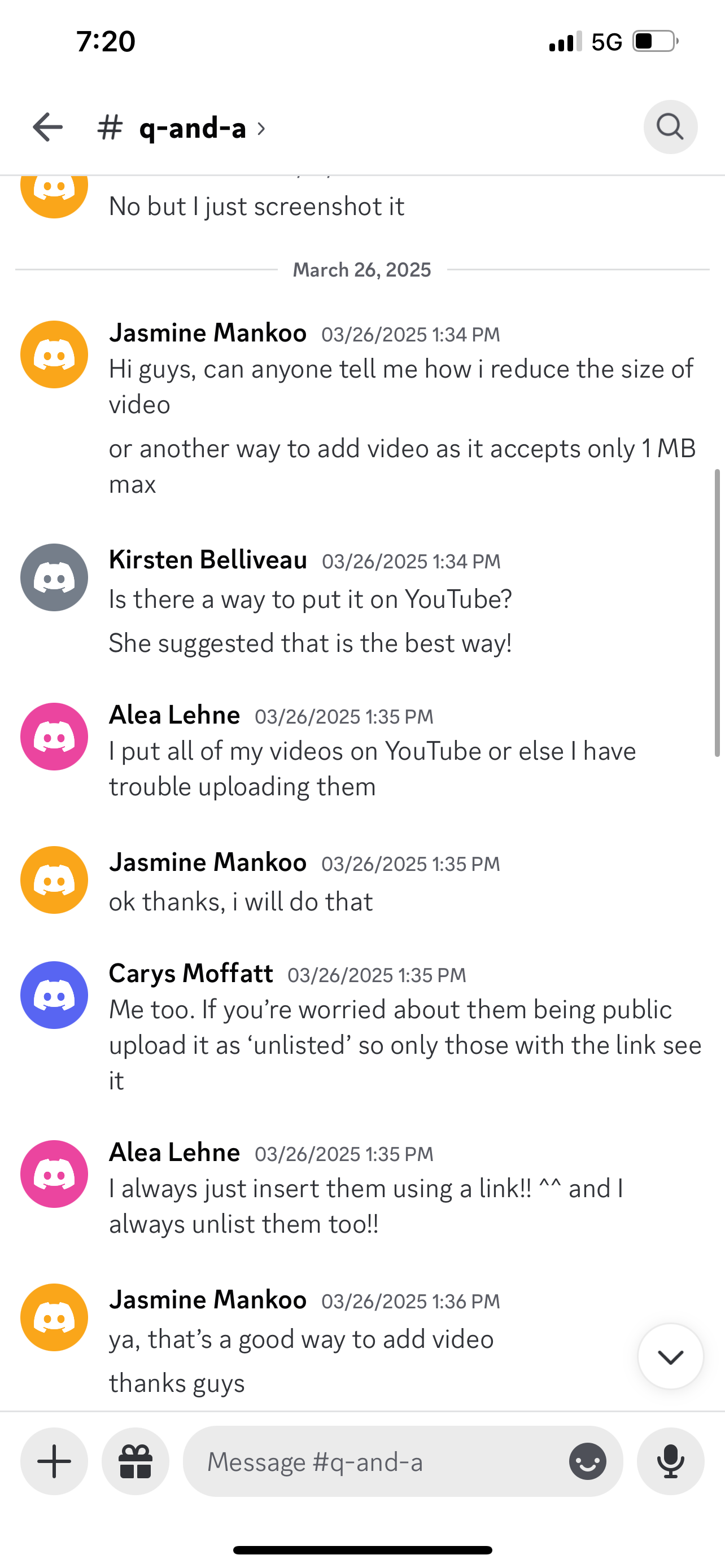
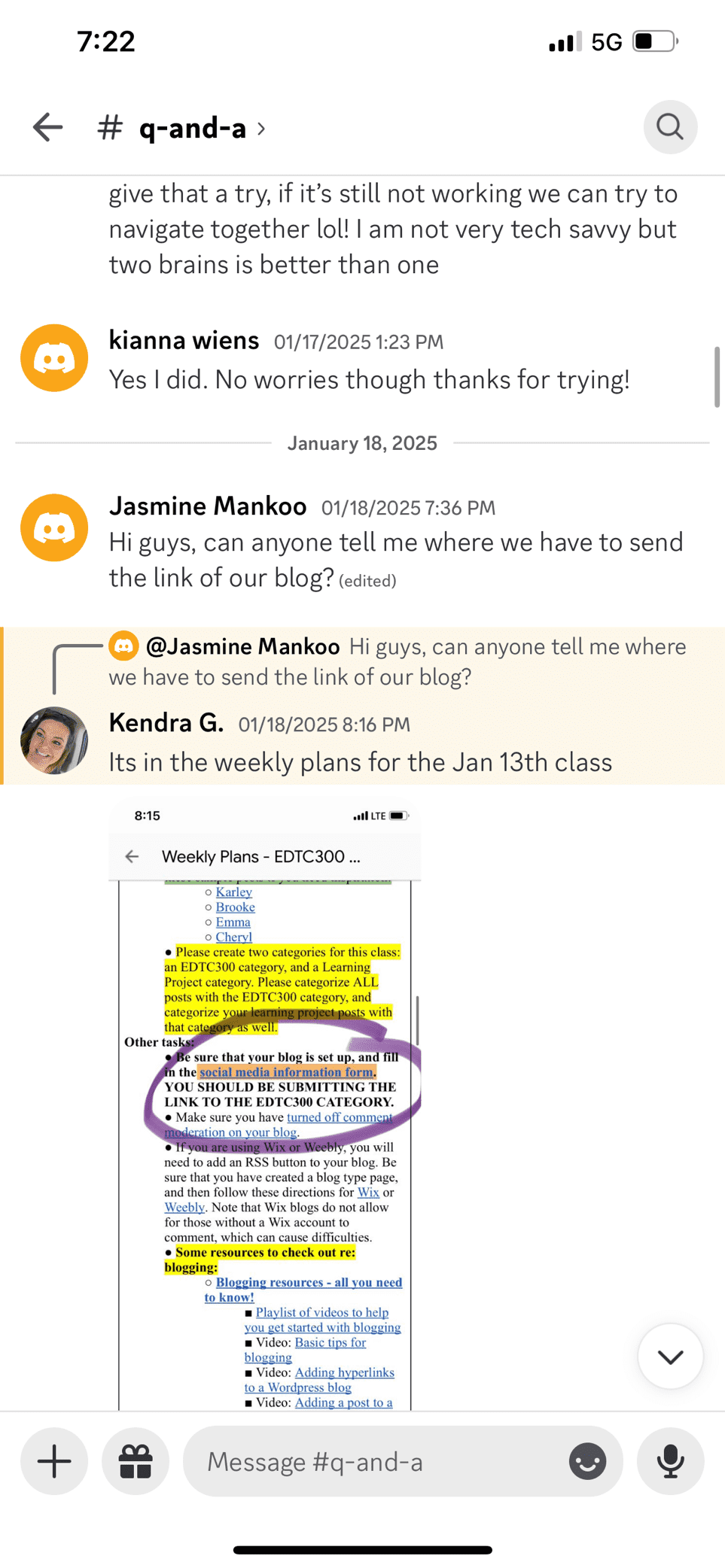
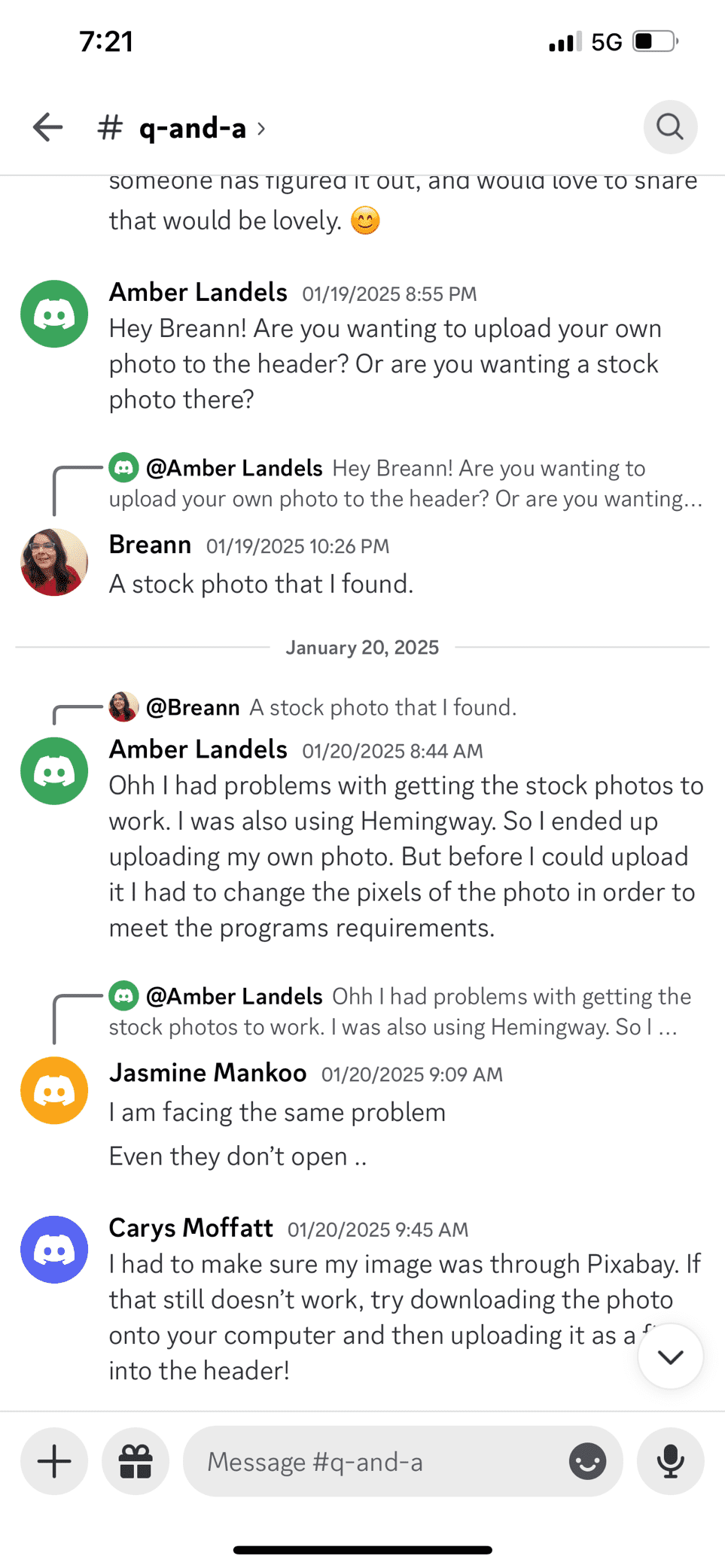
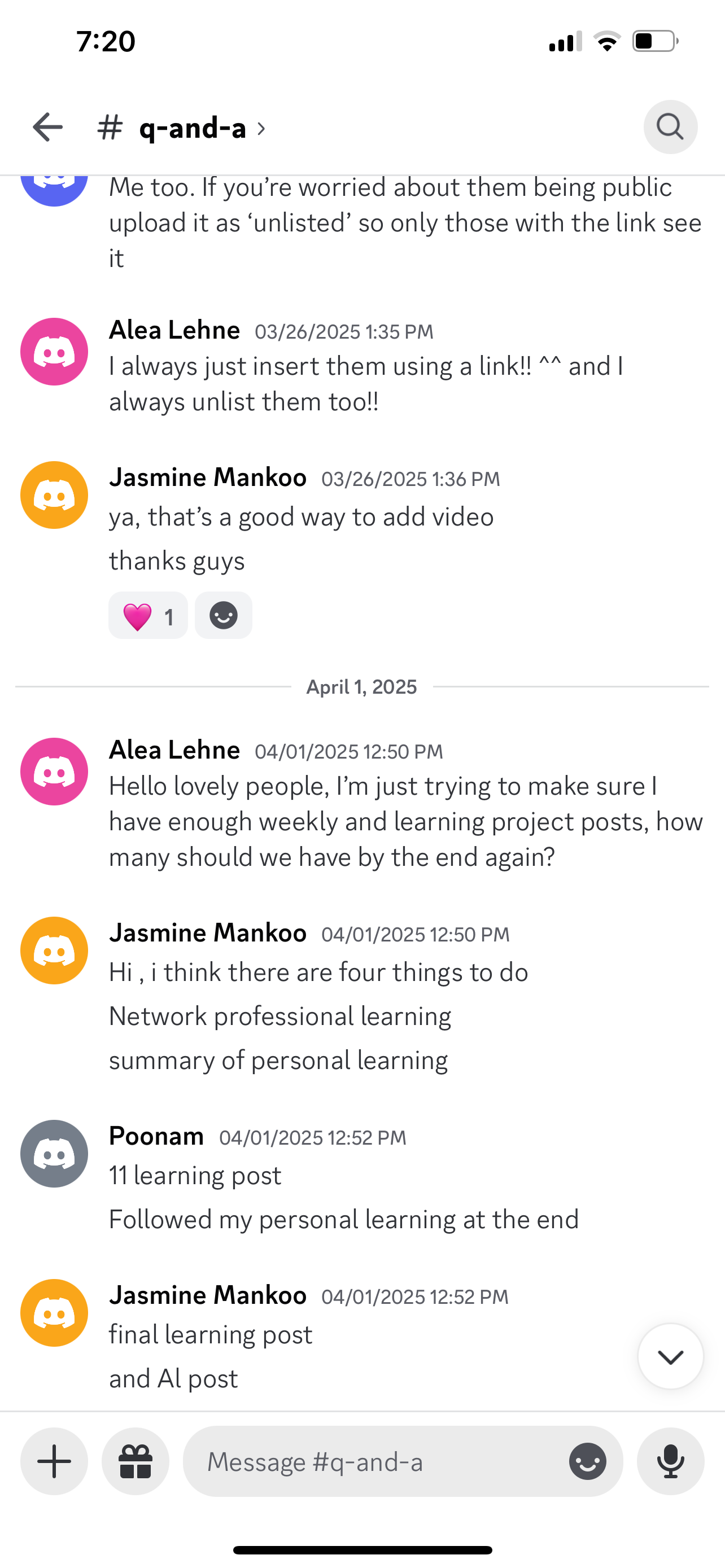
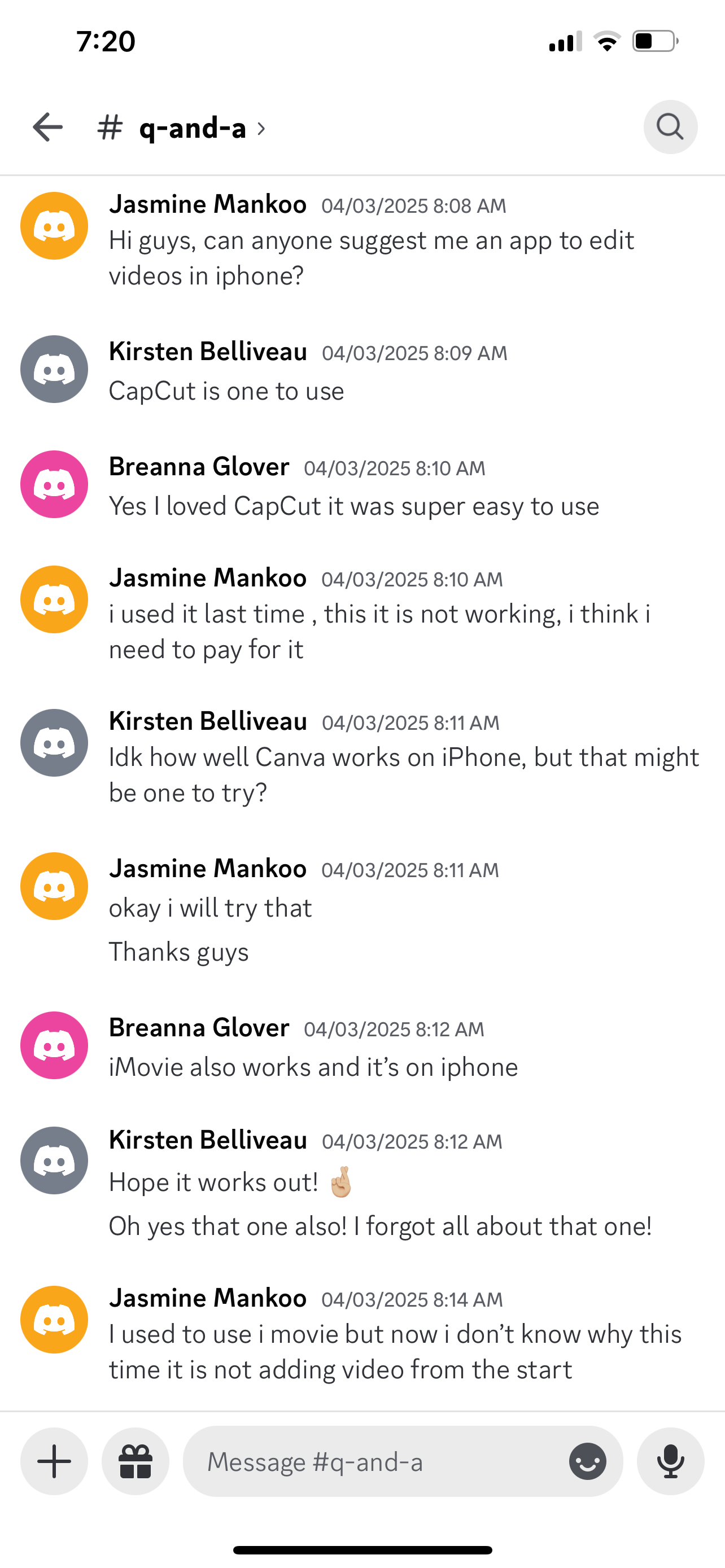
Whether it was solving a tech issue, suggesting a tool, or just showing up with encouragement, I tried to be a consistent and supportive presence for others in our online classroom.
Reflection
Helping others throughout this course helped me learn more deeply myself. By answering questions and offering feedback, I improved my own understanding. Most importantly, I’ve learned that being part of a learning community is about showing up for others — not just when it’s convenient, but when it’s meaningful. I’m proud of the connections I’ve made and the ways I’ve contributed.
Exploring Magic School AI: A Teacher’s Reflection
I explored Magic School AI, a tool designed specifically for educators. I hadn’t used it before, and after trying out a few of its features, I was impressed by its potential to support teaching and learning in creative and efficient ways.
What I Tried
Here are a few of the features I explored:
-
🎶 Song Generator: I started by giving it the topic “different seasons”, and within seconds, it created a catchy, age-appropriate song that could be used to introduce or review the concept in class. What made it even better was the option to generate a lesson plan around the song, including activities and follow-up questions. It also offered a downloadable Song Lesson Plan, which would be super handy for preparing handouts or saving for future use.
-
 📚 Vocabulary Builder: I entered five words and received definitions plus teaching activities to use with students.
📚 Vocabulary Builder: I entered five words and received definitions plus teaching activities to use with students.
-
🌍 Real-World Connections: I gave it a topic, and it generated meaningful examples to help students relate the concept to everyday life.

I also noticed useful tools like rubric makers, behavior note generators, and email writing assistants, all of which could save teachers a lot of planning time.
How It Enhances Teaching
Magic School AI can:
-
✔ Support personalized learning by adapting tasks for student needs
-
✔ Automate administrative tasks like emails and rubrics
-
✔ Offer engaging learning experiences like songs, games, and real-world examples
Supporting All Learners
This tool supports different learning styles:
-
Visual and auditory learners benefit from songs and visuals
-
Kinesthetic learners benefit from the suggested activities
-
It also encourages critical thinking and creativity through storytelling and real-world problem solving
Ethical and Practical Considerations
While AI tools like this are helpful, there are a few things to keep in mind:
-
Use AI as a support, not a replacement for teacher expertise
-
Review content carefully to make sure it fits curriculum and age level
-
Be aware of student data privacy
My Perspective and the Future of AI in Education
I see tools like Magic School AI as a valuable teaching assistant great for saving time, boosting creativity, and helping meet the needs of all learners. It assists teachers to focus on deeper connections with students and instructional quality. Looking ahead, I believe AI will become a regular part of education. If used thoughtfully, it can help make learning more engaging, personalized, and efficient—for both students and teachers.
Magic School AI surprised me in the best way. I’ll definitely consider using it in the future to plan lessons, support students, and stay organized. It’s a fun and practical tool for 21st-century teaching!
My Hour of Code Experience with Code Monkey Blocks Jumper
Introduction
For my Hour of Code activity, I chose Code Monkey Blocks Jumper, a game -based coding challenge that teaches programming logic through block-based coding. The goal was to help a monkey reach a star by giving it movement commands and adjusting the game environment.
coding challenge that teaches programming logic through block-based coding. The goal was to help a monkey reach a star by giving it movement commands and adjusting the game environment.
My Progress & Challenges
I started with excitement, but I quickly realized that some exercises were trickier than expected!
- Exercise 7: I got stuck for a while. The instructions were there, but they weren’t entirely clear. After several attempts, I realized that changing the speed of the monkey helped me pass the level, even though speed adjustment wasn’t mentioned in the instructions.
-
Exercise 9: This one asked me to delete some tiles to create gaps. However, the instructions didn’t clearly explain how to remove them. After some trial and error, I discovered that using the eraser tool worked, and I was able to continue. These moments were frustrating, but I learned the importance of experimenting and problem-solving when coding.
What I Learned Coding requires patience and persistence. Even when instructions aren’t clear, trying different approaches helps.
Debugging is part of the process. Sometimes, what seems like an error is actually just an opportunity to tweak and improve the code.
Thinking outside the box can be useful. Adjusting the monkey’s speed wasn’t mentioned, but it ended up being the key to solving Exercise 7.
My Thoughts on Coding
I had so much fun doing this activity! Even though I got stuck a few times, I really enjoyed figuring out the puzzles and watching my monkey successfully reach the star. It felt rewarding every time I solved a tricky challenge.
Is Coding Important?
I believe coding is an important skill, even if you’re not planning to become a programmer. It teaches:
✔ Problem-solving – Figuring out errors and solutions.
✔ Logical thinking – Understanding how small steps lead to a final goal.
✔ Creativity – Finding different ways to solve a problem (like adjusting speed when it wasn’t in the instructions!).
My Achievement: Jumpy Ride! 🎉
I completed the Block Jumper mini-course and earned the Jumpy Ride achievement! 🎖️ It feels great to complete the challenge and see how much I’ve learned.
Conclusion
Despite the challenges, this experience was fun and rewarding! I learned that coding isn’t just about following instructions—it’s about experimenting, making mistakes, and improving. I’m glad I stuck with it, and I’d love to try more coding activities in the future.
Teaching Digital Literacy: Developing Critical Thinkers in the Digital Age
Balancing Digital Freedom and Accountability: Exploring the Right to Be Forgotten
Approaching Digital Citizenship in My Classroom
Approaching Digital Citizenship in My Classroom
I aim to empower students as responsible, ethical, and critical digital citizens by embedding digital citizenship across subjects rather than isolating it as a separate unit. Students must learn ethical awareness, responsibility, and develop critical thinking skills for healthy digital interactions.
Jason Ohler’s argument that ethics should be the foundation of digital decision-making and Nathan Jurgenson’s critique of the online vs. offline divide will shape my approach, ensuring that students see digital engagement as an extension of their real-world responsibilities.

Connection to Ohler & Jurgenson’s Perspectives
According to Ohler, we need to include character education in digital spaces because virtual environments have the same social impact as traditional face-to-face encounters. Digital citizenship should incorporate ethical decision-making to help students build moral principles for both online and offline environments. I would integrate his ideas by embedding ethical dilemmas into my lessons (e.g., “What would you do if you saw cyberbullying?” or “How do we handle misinformation?”).
- Nathan Jurgenson’s “The IRL Fetish”
Jurgenson disputes the belief that online interactions hold less meaningful value than those conducted in person. He illustrates how digital technology permeates every aspect of our daily life which necessitates students to learn about the genuine effects of their digital choices. I would make sure that in-person learning and digital engagement are not separate, but as an integrated tool for thinking, collaborating, and learning , like books, discussions, and hands-on activities. Instead of seeing digital spaces as “less real,” I would embed online activities like online discussions, collaborative digital projects, and research assignments alongside traditional classroom activities, which will assist the students to understand that digital environments serve as legitimate areas for educational exploration and imaginative growth as well as social networking.

By embedding digital citizenship across subjects, students will:
✅ Able to develop ethical decision-making skills in real-world digital contexts.
✅ Students need to learn critical online information analysis when working on their different subjects.
✅ Students will understand that online actions have real consequences, fostering responsible behavior.
✅ Students will learn that the internet functions as a fully integrated dimension of contemporary existence instead of viewing it separately from their other life activities
This method helps students internalize digital citizenship principles naturally, rather than memorizing rules in a disconnected lesson.
Embedding Digital Citizenship Across Subjects (Examples)
- In English and Social Studies, students can practice digital literacy by fact-checking online sources and analyzing bias in digital media.
- In Science and Math, they can discuss ethical data use and digital security to protect personal information in research.
- In collaborative projects, students will practice digital etiquette by engaging in respectful discussions and providing constructive feedback online.
Teaching the 9 Elements of Digital Citizenship
I will address the nine elements of digital citizenship through activities embedded in daily learning:
| Element | Application in the Classroom |
| Digital Access | Discuss the digital divide and find ways to make sure equal access. |
| Digital Commerce | Analyze online advertising, discuss ethical consumerism, and evaluate persuasive digital marketing techniques. |
| Digital Communication | Compare tone and intent in in-person vs. online discussions, emphasizing responsible online communication. |
| Digital Literacy | Teach students to verify online sources, identify misinformation, and critically evaluate digital media. |
| Digital Etiquette | Establish classroom norms for respectful online interactions and hold students accountable for their digital behavior. |
| Digital Law | Discuss plagiarism, copyright laws, and ethical content creation in research and class assignments. |
| Digital Rights & Responsibilities | Motivate students to reflect on their digital footprint and their role in maintaining a positive online presence. |
| Digital Health & Wellness | Address screen time management, online stress, and strategies for maintaining a balance between digital and real-world life. |
| Digital Security | Teach students to recognize scams, use strong passwords, and protect their personal information. |
Compress App: A Handy Tool for Reducing Image Sizes
Last week, I faced a challenge while working on my blog. The platform only accepts
images up to 1 MB, but the pictures I take on my phone are 3–4 MB—a huge difference!
I spent a lot of time searching for apps and adjusting settings on my phone,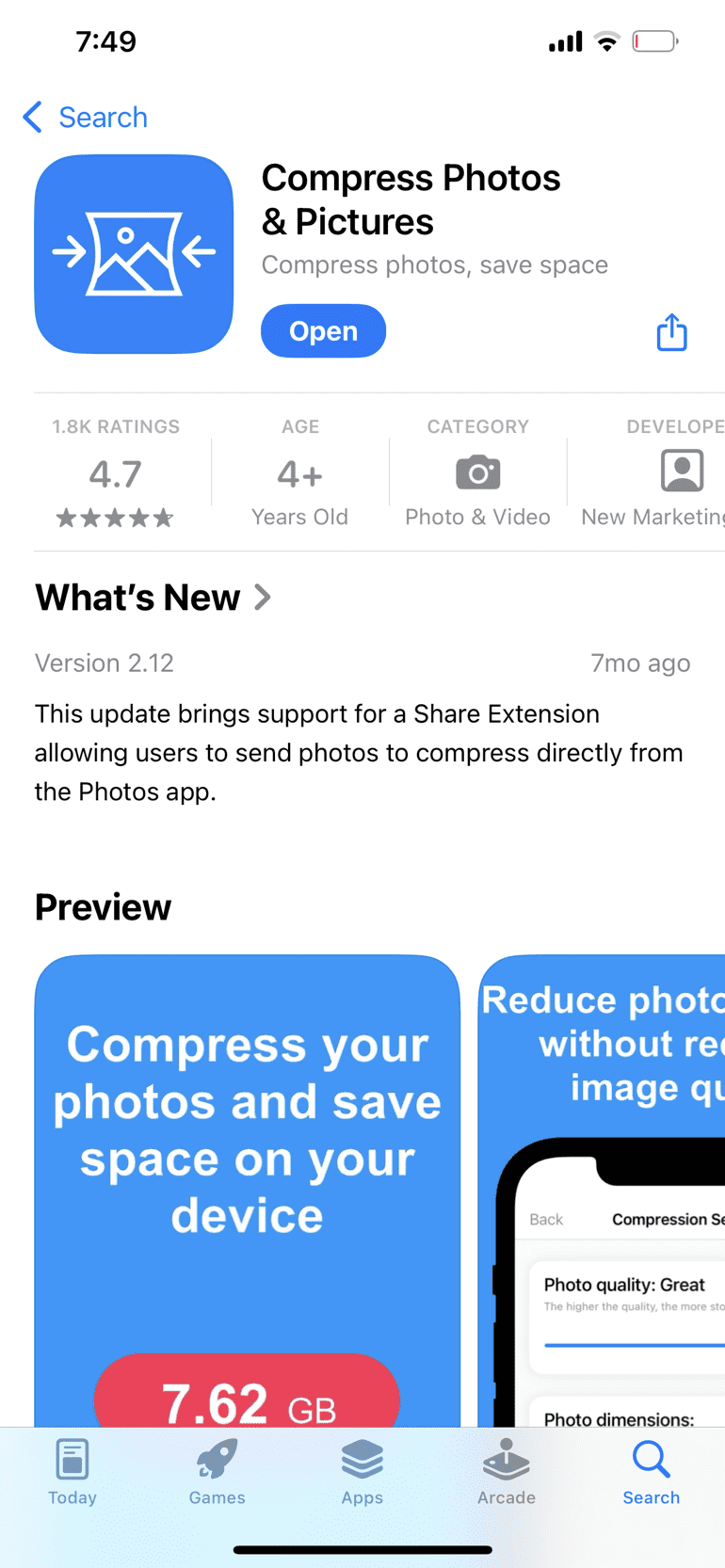 hoping to find an easy way to reduce the file size without compromising quality. Finally, I found a solution: an app called Compress. I found it a bit confusing when I first used it, but after my second try, I fully understood how it worked. Now, I use it regularly, and I find it extremely useful for the following reasons:
hoping to find an easy way to reduce the file size without compromising quality. Finally, I found a solution: an app called Compress. I found it a bit confusing when I first used it, but after my second try, I fully understood how it worked. Now, I use it regularly, and I find it extremely useful for the following reasons:
Why Compress is a Great Tool
✅ Simple Interface: After a little practice, the app becomes very easy to use.
✅ High-Quality Compression: It reduces file size while keeping good image quality.
✅ Batch Processing: You can compress three images at once.
✅ Customizable Settings: You can choose the level of compression you need.
✅ Fast Processing: The compression process is quick, saving a lot of time.
❌ What I Don’t Like About Compress
🚫 Too Many Ads: One thing that irritates me about this app is the number
of ads that pop up while using it. If you’re in a hurry and don’t have a lot of time to spend,
these interruptions can be frustrating.  How to Use Compress (Step-by-Step Guide)
How to Use Compress (Step-by-Step Guide)
Step 1: Download and install the Compress app from the App Store or Google Play.
Step 2: Open the app and select the image(s) you want to compress.
Step 3: Choose your preferred compression level.
Step 4: Click the “Compress” button and wait a few seconds.
Step 5: Save the compressed image to your gallery or share it directly.Using Compress in the Classroom & the SAMR Model
This app can be incredibly useful in an educational setting. Here’s how it fits into the SAMR model:
- Substitution: Instead of uploading large images that take a long time to load, students can use Compress to reduce file sizes before submitting work.
- Augmentation: Teachers can save storage space and improve website performance by using smaller images in online materials.
- Modification: Students can use the app to compress images for multimedia projects, improving efficiency.
- Redefinition: The app allows students to easily share compressed images in collaborative projects without worrying about file size limits.
How I Used Compress for My Learning Project
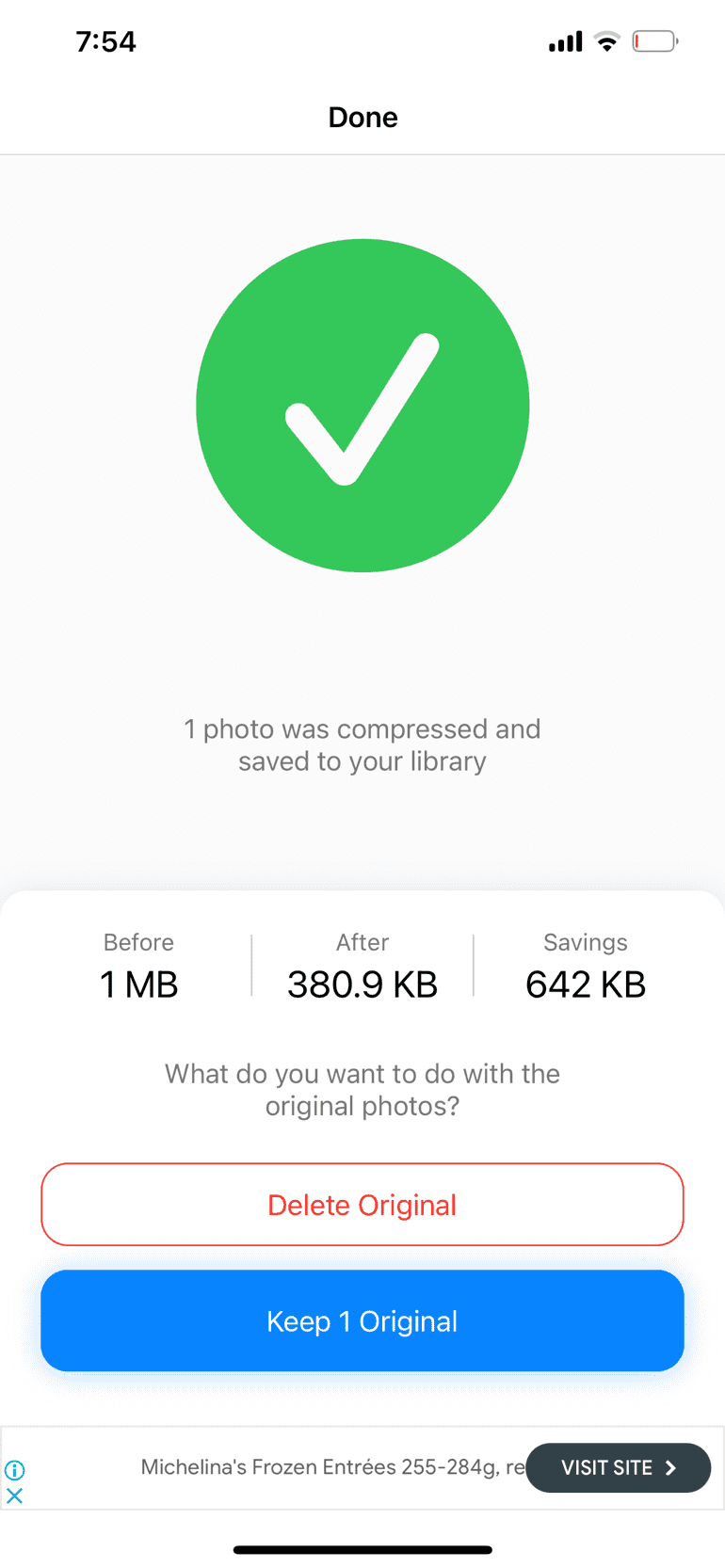 As part of my learning project, I’m documenting my progress in crocheting. I take lots of pictures of my work, but since my phone’s camera produces large file sizes, I needed a way to reduce them for my blog.
As part of my learning project, I’m documenting my progress in crocheting. I take lots of pictures of my work, but since my phone’s camera produces large file sizes, I needed a way to reduce them for my blog.
I used Compress to shrink the images before uploading them. Here’s what I found:
✅ The compressed images loaded faster on my blog.
✅ I was able to upload more pictures without hitting storage limits.
✅ The image quality remained clear and detailed.
⬅️Here’s an example of an image before and after compression:
Reflection
If you need an easy and effective way to reduce image sizes, the Compress app is a great choice. However, be prepared for a lot of ads, which can be frustrating if you’re short on time.
Have you used Compress or a similar app? Let me know your thoughts in the comments!
Role of technology in my daily life
In the era of technology, we are completely dependent on it. It plays an important role from the start of the day until bedtime.  I also use different apps and websites in my daily life, such as WhatsApp to call my parents and friends. Check the daily posts and activities from around the world using a news app. Moreover, these days I use the weather app a lot. I also use Snapchat, Instagram, and FB to interact with my friends and see their daily posts. For study purposes, I frequently use Google, MS Word, Google Sheets, Notes, Canva, Ur Courses, and MS PowerPoint a lot.
I also use different apps and websites in my daily life, such as WhatsApp to call my parents and friends. Check the daily posts and activities from around the world using a news app. Moreover, these days I use the weather app a lot. I also use Snapchat, Instagram, and FB to interact with my friends and see their daily posts. For study purposes, I frequently use Google, MS Word, Google Sheets, Notes, Canva, Ur Courses, and MS PowerPoint a lot.
Efficient use of technology
I rely on the alarm application on the phone to stay organized and assist me in completing my work within a given period. These days I am also writing a research paper, and one of my friends introduced me to the Google Scholar website. I did not know about this simple way to search for different scholars’ literature all in one place. We can search out different articles, books, abstracts, and opinions from academic publishers, professional societies, online repositories, universities, and websites.
Time spend on social Media
I believe that I spend a lot of time on Instagram. I pick up the phone after certain intervals and start scrolling Instagram Reels and checking my friend’s posts. I want to reduce the time of using Instagram and want to use it in productive ways.
Strategies to balancing social media usage
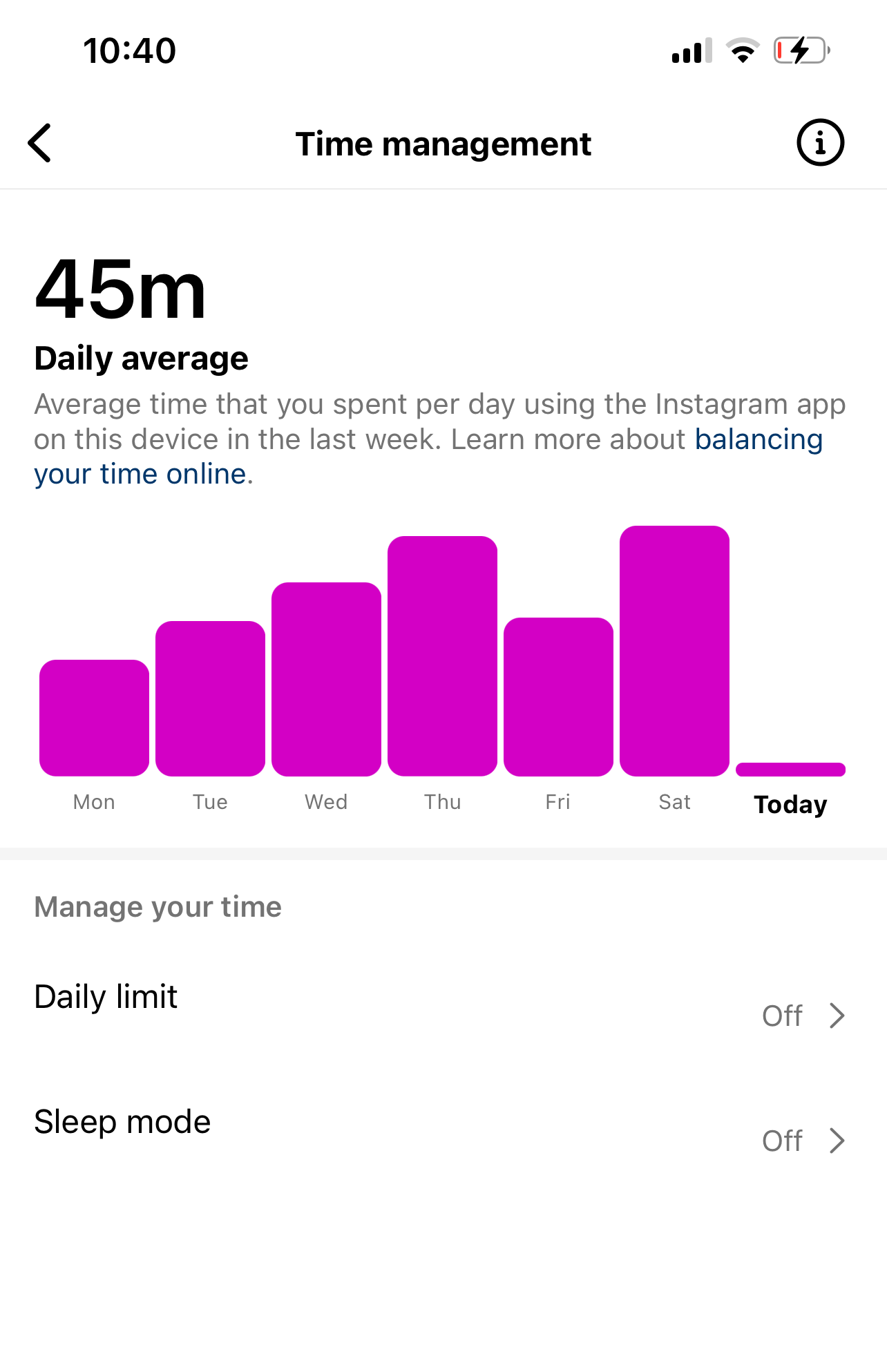
To overcome this, I have started using a feature in Instagram where one can manage their activity. When we go to our profile, we tap on the three lines in the top right corner and then select your activity. Under the “How to use Instagram” section, we will find the option of time spent. It shows the time we spend on Instagram daily which helps us to track it. Another feature I like is the ability to manage time; we can set a daily limit to use Instagram under the same option.
I also set the time boundaries by using the alarm app. I set a particular time and set an alarm, which helps to keep remembering that this is the time for myself and other productive activities. By combining these tools, I hope to make my social media time more mindful and balanced, allowing me to focus on more important tasks.
Get familiar with me
 Hello everyone, my name is Jasmine Kaur. I was born and raised in Punjab, India. I hold a Master’s degree in Botany with a specialization in Cytogenetics and Plant Breeding, and a Bachelor’s degree in Medical Sciences, both from India. Professionally, I served as an Assistant Professor at SGGSWU University back in India and also worked as a post-graduate teacher at a school. Three years ago, I moved to Regina, Canada, where I live with my husband, our adorable baby, and my in-laws. I have a deep passion for flowers, drawing, painting, and gardening, as they allow me to connect with nature and express my creativity.
Hello everyone, my name is Jasmine Kaur. I was born and raised in Punjab, India. I hold a Master’s degree in Botany with a specialization in Cytogenetics and Plant Breeding, and a Bachelor’s degree in Medical Sciences, both from India. Professionally, I served as an Assistant Professor at SGGSWU University back in India and also worked as a post-graduate teacher at a school. Three years ago, I moved to Regina, Canada, where I live with my husband, our adorable baby, and my in-laws. I have a deep passion for flowers, drawing, painting, and gardening, as they allow me to connect with nature and express my creativity.
Currently, I am in my second year of the Bachelor of Education (B.Ed.) after-degree program, which has given me the opportunity to explore and expand my knowledge of educational technology. This program is helping me develop a deeper understanding of the ways technology can enhance learning experiences.
Although I am not very familiar with blogging yet, I’ve heard a lot about it and it is a kind of website which update regularly knowledgeable content . I believe it’s a wonderful contemporary platform to not only learn from others but also to share and gain valuable insights. I’m really excited to dive deeper into the world of blogging, connect with my classmates, and learn from their blogs as well. It’s an exciting journey, and I look forward to engaging with this community.




 evaluation, media bias analysis, and fact-checking exercises. Another effective way to do this is through a news comparison activity, where students can analyze multiple articles or news at the same event.
evaluation, media bias analysis, and fact-checking exercises. Another effective way to do this is through a news comparison activity, where students can analyze multiple articles or news at the same event.  sources, asking probing questions, and comprehending how algorithms influence online experiences. Comparing social media algorithms and how they affect the information people view online is one method to include these tactics. This has a direct bearing on the
sources, asking probing questions, and comprehending how algorithms influence online experiences. Comparing social media algorithms and how they affect the information people view online is one method to include these tactics. This has a direct bearing on the 
 follow us for the rest of our lives. A frustrated post or a mistake from years ago may reappear and impact relationships, employment prospects, and college admissions. This raises the question: Should people be able to remove specific elements of their digital history?
follow us for the rest of our lives. A frustrated post or a mistake from years ago may reappear and impact relationships, employment prospects, and college admissions. This raises the question: Should people be able to remove specific elements of their digital history? challenging the idea that the internet is a distinct universe. He criticizes the propensity to view online behavior as “less real,” even when it has long-term repercussions. The “right to be forgotten” is a legal notion that permits anyone to request that outdated or harmful online information be removed. This is in keeping with the debate around this idea. Protecting people’s freedom to create their digital identities ought to be a fundamental right if we agree with Jurgenson’s contention that digital environments are inextricably linked to real life.
challenging the idea that the internet is a distinct universe. He criticizes the propensity to view online behavior as “less real,” even when it has long-term repercussions. The “right to be forgotten” is a legal notion that permits anyone to request that outdated or harmful online information be removed. This is in keeping with the debate around this idea. Protecting people’s freedom to create their digital identities ought to be a fundamental right if we agree with Jurgenson’s contention that digital environments are inextricably linked to real life.